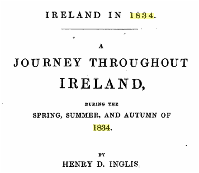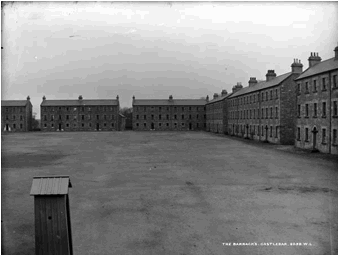Title of project: Castlebar, 1834.
Caisleán an Bharraigh, 1834.
This is a review of a dramatic time of change in Castlebar. The years 1830-1834 saw a lot of developments, culminating in the completion of three important buildings which contributed to the administration of the town: the new court house, the cavalry and infantry barracks, and the infirmary. The government invested a lot in the construction of these facilities, and evidently regarded Castlebar as the most important town in Mayo. These labour-intensive projects stimulated a lot of growth in the town, particularly during the construction phase. The class found information about this period in Castlebar from a variety of websites, contemporary eye-witness accounts, issues of the Castlebar Parish Magazine and photos from the National Library of Ireland. What follows is a collection of salient information from these sources. (Gearóid Ó Marcaigh, teacher)
Pigot’s Directory, 1824 http://www.swilson.info/wp/?p=1090
The public buildings are the castle, which stands on a commanding situation, and is now occupied as a barrack; the jail; a fine, convenient court-house; another barrack; a county infirmary; a linen-hall…the population of the town is 5,120.
I have learned from this that the barracks, the courthouse and the infirmary built in 1834 in Castlebar were not the first ones. I found out that the population two years ago was 12,318. I can see that the population of Co. Mayo has halved in the past 191 years but more than doubled in Castlebar over the years. (below)
Population figures: www.from-Ireland.net
I learned that the population in mayo in 1821 was 293,112 in 1831 it was 376,956. The population was growing fast, so Castlebar must have been getting crowded. But the population of Mayo now is only 130,552. A lot of people must have died or left the county. (Sam)
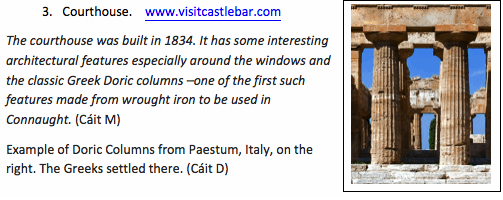
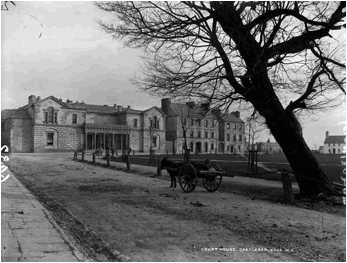
http://catalogue.nli.ie/ (National Library photographic archives)Architecture and Heritage. www.courts.ie
Castlebar Courthouse has and always had an eclectic mix of architectural styles reflecting its many extensions and modifications over the last two hundred years.
The Doric columns that are at the courthouse were meant to be stone, the iron ones were meant to go to India. There was a mix-up at the port in Southampton. The iron ones came to Co. Mayo and the stone ones went to India. I learnt that from my uncle. (Cáit D)The Courthouses of Ireland, a book by Dunne and Phillips
Trouble!: The above book disagrees with the article in castlebar.com. The book says that the main reconstruction of the courthouse took place in c. 1821, with further modifications (including the wrought iron columns) being built c. 1860. This claim is supported by an article I found in the Connaught Telegraph. (Gearóid)
Connaught Telegraph, Dec 22 1858:
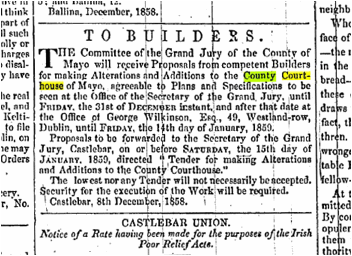
I tried to find more about this building work in other copies of the Telegraph on the computer at the library in Castlebar, but I couldn’t find any other articles. It was odd that there was very little coverage of an important local building project.
Contemporary Eye-Witness account https://books.google.ie/
Ireland in 1834, a journey, Volume 1 By Henry David Inglis
“The cottages by the way-side, were all of the poorest description; and the small patches of cultivation round them, and the absence of grazing land, shewed that these people might be classed among the poor of Mayo.

www.oldirishimages.com
I also noticed a good many cabins padlocked; and was told that the owners had gone to harvesting, either in the Low Countries, or in England. We have certainly no proof of a want of will among the Irish peasantry to work, in the thousands who travel each season from the remotest parts of Ireland, to earn a pound or two at laborious harvest work; and carry back, sewed up in the sleeve of their ragged coat , or elsewhere, these hard and far-sought earnings, to pay the rent of their cabin and bit of potato-land.”
In 1834 not many people could afford the rent and ended up having to find work in England or the Low Countries. This shows just how poor the farmers really were, but the writer sees that they were not lazy. (Rút)
Achill people left their homeland to get work in Scotland. In 1894, 32 people died on their way to work there. There was another tragedy in 1937. Ten boys died in there in a fire one night. Two of them were grand uncles of mine. One of them was only ten years old. (Sinéad)
Since 2008 there has been a recession this has caused workers to leave the country for work in countries like Australia and England. Ireland is trying to get them back and are doing all they can to end the recession. (Piaras)
“Castlebar is not so pretty a town as Westport; but it is a place of greater business; and it is a considerably larger and more populous town. There is only one good street in Castlebar; but the town contains many lanes; and has very long, bad suburbs of mud cabins. The retail trade of Castlebar, is necessarily good; for no town of considerable size, lies to the north, nearer than Ballina , and none to the east, closer than Boyle, a distance of at least forty miles.” (Inglis)
It is clear to me from this extract that Castlebar wasn’t as nice as Westport at the time, and it needed more buildings and more money put into it. When money was put into Castlebar, in the early 1830’s, it made a considerable difference to the town as a whole. (Seosamh)
My Mud-Cabin Home in Castlebar:
It’s hard being a peasant here in Castlebar. We live in a horrible mud cabin I couldn’t imagine a worse home. It’s cold, damp and wet. We hardly have any money my both parents are unemployed. All we get is a small bit of money from the chickens and from our small potato patch behind the house.
I have six brothers and sisters most under the age of twelve. We sometimes have to stay at home to help out with the work, which is normally a good thing because I don’t like getting hit with a stick across my hand. But when I do go to school I have to walk barefoot for forty-five minutes. (Written by Liam)
More from Inglis:
“I found great want of employment in Castlebar. There had recently been a considerable demand for labour on public works,-a new gaol, and new barracks, having been lately constructed; but these works were now completed; and the labour market was consequently more overstocked than before they begun.”
At first, I was quite surprised by this passage. You’d think there’d be plenty of jobs because of all of the buildings that were being built. I then came to the conclusion that these buildings had been finished by the time H. D. Inglis came to the town in 1834. That meant that there was a lot of people who had came to the town for work, but then soon after everything was finished and they didn’t have jobs any more. That led to over-population and not enough jobs for everyone in the town so there was now a lack of employment. This is similar to what happened in Ireland during and after the Celtic Tiger. There were a lot of jobs in Ireland, especially in construction. People came from abroad to work here. After 2007 there was a recession. Many people became unemployed. (Sam)
http://catalogue.nli.ie/ (National Library photographic archives)
Castlebar Parish Magazine. Two articles:
Following the insurrection of 1798 and the French landing under General Humbert at Kilcummin pier in North Mayo, a number of new installations were planned by the British to guard against further invasions. Amongst these installations were Martello Towers built around the coast and two barracks in Castlebar. These two barracks were the Cavalry Barracks which later became the Guards Barracks. The building was demolished when the new Garda Headquarters were built. The other was the Artillery Barracks which later became the Military Barracks. Lord Lucan was the principal landlord in the area at the time and his house stood in the lawn which is behind the east wall of the barracks. The land for the barracks was obtained from Lord Lucan and the official lease is dated 1827.
Castlebar Parish Magazine
“A brief history of Castlebar Military Barracks” (research by Darragh)
John Burrow Esq. passed through Castlebar in 1836, on his “Tour Around Ireland.” He gives us a good account of what the town was like on market day and paints a happy picture of prosperity and self-improvement. He writes: “the houses are good and evidently inhabited by a respectable class of merchants and shopkeepers.”
It was market day when he arrived and the town was crowded from one end to the other. Burrow was impressed by both the range of goods on offer and by the competitive prices. Turkeys and geese sold for tenpence each in the market, and Burrow thought he had found a real bargain when he was offered “two live fowls” for ninepence, though he observed that “one to be sure looked more dead than alive.”
Castlebar Parish Magazine 1994
“A good little town” By Liam Waldron (research by Tiana)
The Infirmary. www.mayo-ireland.ie:
On the site of the current Mayo County Council building, the county infirmary was built in 1834 and was in use until 1932.
The County Infirmary, opposite the Mall, Castlebar, was a three-storey structure, tastefully designed and erected in or about 1750 by means of a grant allocated by the Irish Parliament in College Green, Dublin.
Dr. M. O'Malley Knott was County Surgeon for a number of years. There were 60 beds in the infirmary and the number of patients treated over a year would have been 1,000. Dr. Knott served during the closing stages of the 19th century and the opening years of the 20th century.
Ould Stock on October 24, 2004 at www.Castlebar.ie
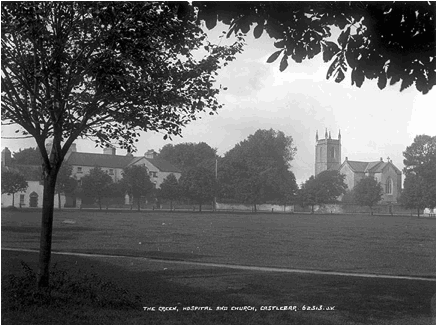
http://catalogue.nli.ie/ (National Library photographic archives)
The Infirmary. http://www.navanhistory.ie/index.php?page=county-infirmary
An account of Navan Infirmary, a similar hospital to the one in Castlebar. It says that in 1848: The old alcohol and bleeding treatment still lingered on, some £90 being spent on wine, porter and leeches.
From the London Times, 25th May 1846:
Glanders in the Human Subject
A case of this frightful disease has recently occurred at Navan. The sufferer was a boy named Christopher Clarke, of Rathcoune, about 17 years old, who caught the disease from a glandered horse belonging to his father, which he cared and attended. The infection was received by the boy through a slight cut on one of his fingers. He was brought to the County of Meath infirmary, at Navan, where death ended his sufferings on last Thursday week. His person presented a most appalling spectacle. Mr. William Timmon, apothecary to the institution, informed me that three former patients who died in the infirmary of the disease, within two years were similarily affected.
These accounts from Navan Infirmary show what life was like in the infirmary in Castlebar. It was sad to see that the boy died when he could be made better today with an antibiotic. (Caitríona)
The students enjoyed researching the topic, and come up with an eclectic mix of sources and information. They learned a lot about the period under review. It was a study of a period of Irish history which featured social issues, as opposed to revolutions or wars.
Bibliography:
Pigot’s Directory, 1824 http://www.swilson.info/wp/?p=1090
Population figures. www.from-Ireland.net
Courthouse. www.visitcastlebar.com
National Library photographic archives. http://catalogue.nli.ie/
Additional pictures. www.oldirishimages.com
Architecture and Heritage. www.courts.ie
Connaught Telegraph. Archives from County Library, Castlebar.
Ireland in 1834, a journey, Vol. 1 By Henry David Inglis https://books.google.ie/
Castlebar Parish Magazine. Issues from 1986-2013.
Auld Stock article: www.castlebar.ie
The Infirmary. www.mayo-ireland.ie
http://www.navanhistory.ie/index.php?page=county-infirmary
Title |
The Courthouses of Ireland: A Gazetteer of Irish Courthouses |
Author |
|
Compiled by |
Mildred Dunne, Brian Phillips |
Publisher |
Heritage Council, 1999 |
